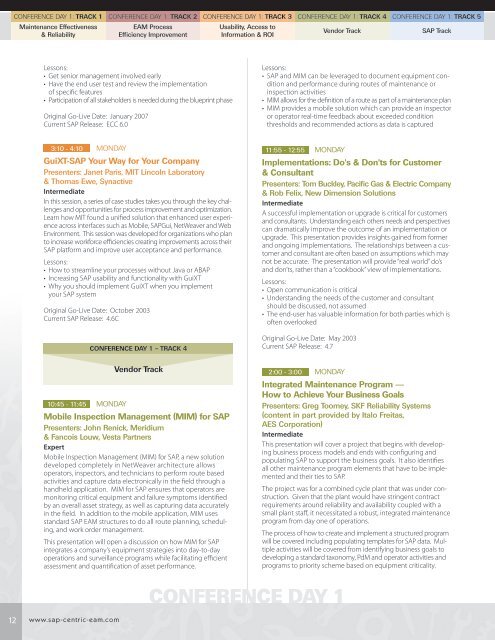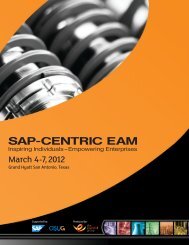March 30 – April 2, 2008 - SAP-Centric EAM
March 30 – April 2, 2008 - SAP-Centric EAM
March 30 – April 2, 2008 - SAP-Centric EAM
You also want an ePaper? Increase the reach of your titles
YUMPU automatically turns print PDFs into web optimized ePapers that Google loves.
1<br />
CONFERENCE DAY 1: TRACK 1<br />
Maintenance Effectiveness<br />
& Reliability<br />
Lessons:<br />
• Get senior management involved early<br />
• Have the end user test and review the implementation<br />
of specific features<br />
• Participation of all stakeholders is needed during the blueprint phase<br />
Original Go-Live Date: January 2007<br />
Current <strong>SAP</strong> Release: ECC 6.0<br />
3:10 - 4:10 MONDAY<br />
GuiXT-<strong>SAP</strong> Your Way for Your Company<br />
Presenters: Janet Paris, MIT Lincoln Laboratory<br />
& Thomas Ewe, Synactive<br />
Intermediate<br />
In this session, a series of case studies takes you through the key challenges<br />
and opportunities for process improvement and optimization.<br />
Learn how MIT found a unified solution that enhanced user experience<br />
across interfaces such as Mobile, <strong>SAP</strong>Gui, NetWeaver and Web<br />
Environment. This session was developed for organizations who plan<br />
to increase workforce efficiencies creating improvements across their<br />
<strong>SAP</strong> platform and improve user acceptance and performance.<br />
Lessons:<br />
• How to streamline your processes without Java or ABAP<br />
• Increasing <strong>SAP</strong> usability and functionality with GuiXT<br />
• Why you should implement GuiXT when you implement<br />
your <strong>SAP</strong> system<br />
Original Go-Live Date: October 2003<br />
Current <strong>SAP</strong> Release: 4.6C<br />
10:45 - 11:45 MONDAY<br />
Mobile Inspection Management (MIM) for <strong>SAP</strong><br />
Presenters: John Renick, Meridium<br />
& Fancois Louw, Vesta Partners<br />
Expert<br />
Mobile Inspection Management (MIM) for <strong>SAP</strong>, a new solution<br />
developed completely in NetWeaver architecture allows<br />
operators, inspectors, and technicians to perform route based<br />
activities and capture data electronically in the field through a<br />
handheld application. MIM for <strong>SAP</strong> ensures that operators are<br />
monitoring critical equipment and failure symptoms identified<br />
by an overall asset strategy, as well as capturing data accurately<br />
in the field. In addition to the mobile application, MIM uses<br />
standard <strong>SAP</strong> <strong>EAM</strong> structures to do all route planning, scheduling,<br />
and work order management.<br />
This presentation will open a discussion on how MIM for <strong>SAP</strong><br />
integrates a company’s equipment strategies into day-to-day<br />
operations and surveillance programs while facilitating efficient<br />
assessment and quantification of asset performance.<br />
www.sap-centric-eam.com<br />
CONFERENCE DAY 1: TRACK 2<br />
<strong>EAM</strong> Process<br />
Eff iciency Improvement<br />
CONFERENCE DAY 1 — TRACK 4<br />
Vendor Track<br />
CONFERENCE DAY 1: TRACK 3<br />
Usability, Access to<br />
Information & ROI<br />
CONFERENCE DAY 1: TRACK 4<br />
Vendor Track<br />
Lessons:<br />
• <strong>SAP</strong> and MIM can be leveraged to document equipment condition<br />
and performance during routes of maintenance or<br />
inspection activities<br />
• MIM allows for the definition of a route as part of a maintenance plan<br />
• MIM provides a mobile solution which can provide an inspector<br />
or operator real-time feedback about exceeded condition<br />
thresholds and recommended actions as data is captured<br />
11:55 - 12:55 MONDAY<br />
Implementations: Do's & Don'ts for Customer<br />
& Consultant<br />
Presenters: Tom Buckley, Pacific Gas & Electric Company<br />
& Rob Felix, New Dimension Solutions<br />
Intermediate<br />
A successful implementation or upgrade is critical for customers<br />
and consultants. Understanding each others needs and perspectives<br />
can dramatically improve the outcome of an implementation or<br />
upgrade. This presentation provides insights gained from former<br />
and ongoing implementations. The relationships between a customer<br />
and consultant are often based on assumptions which may<br />
not be accurate. The presentation will provide “real world” do’s<br />
and don’ts, rather than a “cookbook” view of implementations.<br />
Lessons:<br />
• Open communication is critical<br />
• Understanding the needs of the customer and consultant<br />
should be discussed, not assumed<br />
• The end-user has valuable information for both parties which is<br />
often overlooked<br />
Original Go-Live Date: May 2003<br />
Current <strong>SAP</strong> Release: 4.7<br />
2:00 - 3:00 MONDAY<br />
CONFERENCE DAY 1<br />
CONFERENCE DAY 1: TRACK 5<br />
<strong>SAP</strong> Track<br />
Integrated Maintenance Program —<br />
How to Achieve Your business Goals<br />
Presenters: Greg Toomey, SKF Reliability Systems<br />
(content in part provided by Italo Freitas,<br />
AES Corporation)<br />
Intermediate<br />
This presentation will cover a project that begins with developing<br />
business process models and ends with configuring and<br />
populating <strong>SAP</strong> to support the business goals. It also identifies<br />
all other maintenance program elements that have to be implemented<br />
and their ties to <strong>SAP</strong>.<br />
The project was for a combined cycle plant that was under construction.<br />
Given that the plant would have stringent contract<br />
requirements around reliability and availability coupled with a<br />
small plant staff, it necessitated a robust, integrated maintenance<br />
program from day one of operations.<br />
The process of how to create and implement a structured program<br />
will be covered including populating templates for <strong>SAP</strong> data. Multiple<br />
activities will be covered from identifying business goals to<br />
developing a standard taxonomy, PdM and operator activities and<br />
programs to priority scheme based on equipment criticality.



